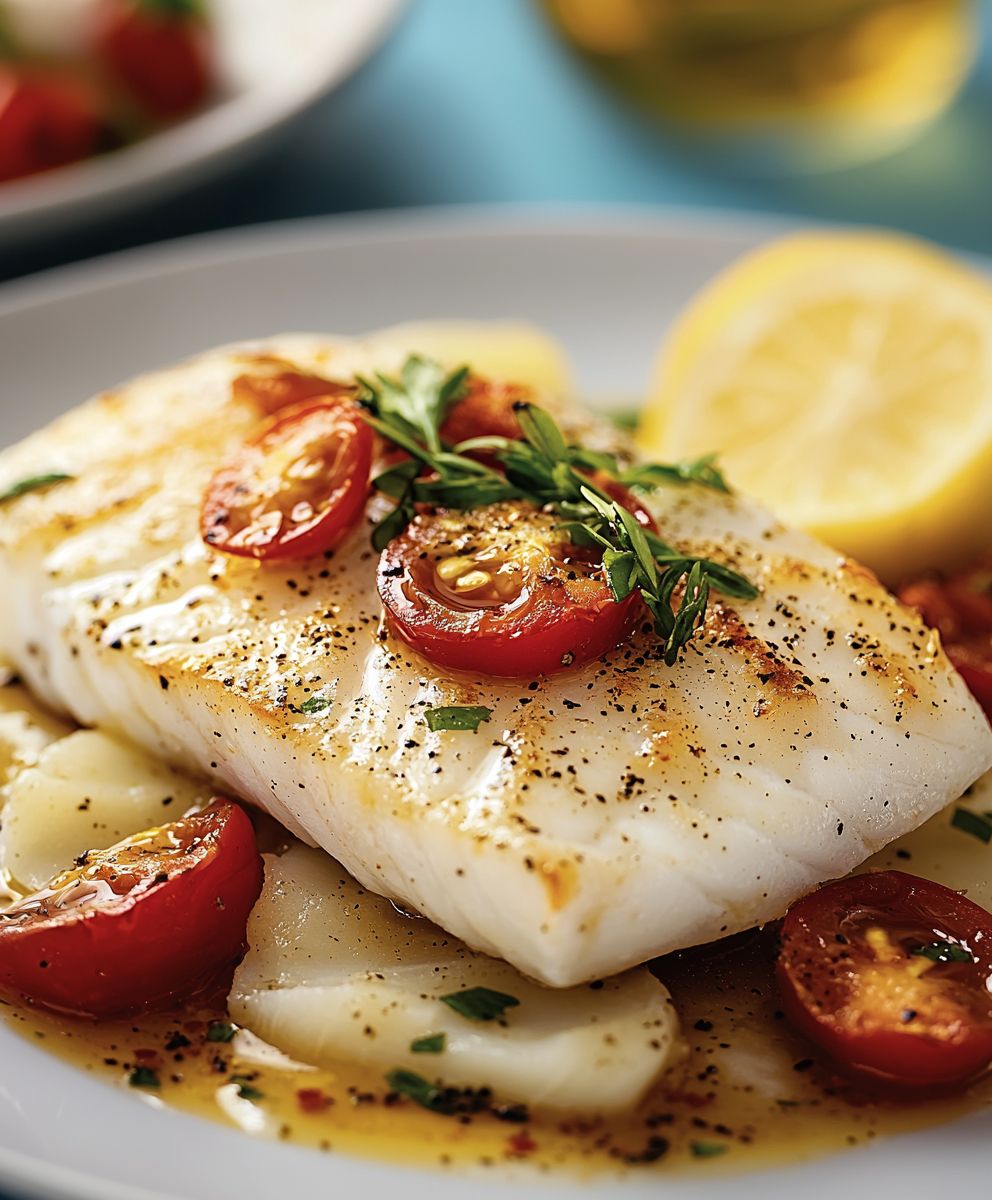Fish en Papillote: Prepare to unlock a world of flavor and simplicity with this classic French cooking technique! Imagine perfectly steamed, flaky fish infused with aromatic herbs, vegetables, and a touch of citrus, all cooked in its own little parchment paper parcel. It’s not just a meal; it’s an experience that’s surprisingly easy to create in your own kitchen.
En papillote, meaning “in parchment” in French, has been a beloved method of cooking for centuries. It’s a technique that beautifully showcases the delicate flavors of fish while locking in moisture, resulting in an incredibly tender and succulent dish. While its origins are firmly rooted in French culinary tradition, the concept of cooking food in enclosed wrappers exists in various cultures around the world, each with its own unique twist and ingredients.
What makes fish en papillote so universally appealing? For starters, it’s incredibly healthy, requiring minimal added fats. The steaming process preserves the natural nutrients and flavors of the ingredients. But beyond its health benefits, people adore this dish for its incredible taste and texture. The fish emerges perfectly cooked, moist, and infused with the vibrant flavors of the accompanying ingredients. Plus, the individual parchment packets make for an elegant and effortless presentation, perfect for both weeknight dinners and special occasions. Let’s dive in and discover how to create this culinary masterpiece!
Ingredients:
- 4 (6-ounce) skinless white fish fillets (cod, halibut, or sea bass work well)
- 1 lemon, thinly sliced
- 1 orange, thinly sliced
- 1 red bell pepper, thinly sliced
- 1 yellow bell pepper, thinly sliced
- 1 zucchini, thinly sliced
- 1 red onion, thinly sliced
- 4 cloves garlic, minced
- 1/4 cup dry white wine (such as Sauvignon Blanc or Pinot Grigio)
- 1/4 cup olive oil
- 2 tablespoons chopped fresh parsley
- 2 tablespoons chopped fresh dill
- 1 tablespoon capers, drained
- 1 teaspoon dried oregano
- 1/2 teaspoon red pepper flakes (optional)
- Salt and freshly ground black pepper to taste
- Parchment paper (4 large sheets, approximately 12×16 inches)
Preparing the Fish and Vegetables:
- First, let’s get our veggies ready. Wash and thoroughly dry all the vegetables. This is important because excess moisture can make the papillote soggy.
- Thinly slice the red and yellow bell peppers. I like to remove the core and seeds first, then slice them into strips about 1/4 inch thick. Uniformity in size helps them cook evenly.
- Next, slice the zucchini into thin rounds. Again, aim for about 1/4 inch thickness. If the zucchini is particularly large, you can halve or quarter the rounds.
- Peel and thinly slice the red onion. I find that red onion adds a nice sweetness and color to the dish.
- Mince the garlic. Freshly minced garlic is always best for flavor.
- Now, let’s prepare the citrus. Thinly slice the lemon and orange. These will add a bright, zesty flavor to the fish.
- Rinse the fish fillets under cold water and pat them dry with paper towels. This helps remove any excess moisture and ensures they cook properly. Season both sides of the fillets generously with salt and freshly ground black pepper. Don’t be shy with the seasoning; it’s essential for a flavorful dish.
- In a small bowl, combine the dry white wine, olive oil, minced garlic, chopped parsley, chopped dill, capers, dried oregano, and red pepper flakes (if using). This mixture will be our flavorful sauce. Whisk everything together until well combined.
Assembling the Papillotes:
- Preheat your oven to 400°F (200°C). This temperature is ideal for cooking the fish and vegetables in the parchment paper.
- Prepare your parchment paper. You’ll need four large sheets, approximately 12×16 inches each. Fold each sheet in half crosswise.
- Open one of the folded parchment paper sheets. On one half of the parchment, arrange a layer of sliced red onion, followed by a layer of sliced bell peppers and zucchini. This creates a bed for the fish and prevents it from sticking to the parchment.
- Place one seasoned fish fillet on top of the vegetable bed.
- Drizzle about 2 tablespoons of the white wine and herb sauce over the fish fillet.
- Arrange a few slices of lemon and orange on top of the fish.
- Repeat steps 3-6 for the remaining three fish fillets and parchment paper sheets.
- Now, it’s time to seal the papillotes. Fold the other half of the parchment paper over the fish and vegetables. Starting at one corner, fold the edges of the parchment paper inward, creating a tight seal. Continue folding along the entire edge, crimping the paper as you go. This creates a sealed packet that will trap the steam and cook the fish and vegetables evenly. Make sure the seal is tight to prevent steam from escaping.
Baking the Fish en Papillote:
- Place the sealed papillotes on a baking sheet. Make sure they are not overlapping.
- Bake in the preheated oven for 15-20 minutes, or until the parchment paper is puffed up and lightly browned. The cooking time will depend on the thickness of the fish fillets. You can check for doneness by carefully opening one of the papillotes. The fish should be opaque and flake easily with a fork.
- Carefully remove the baking sheet from the oven. Be careful when opening the papillotes, as hot steam will escape.
Serving:
- Serve the fish en papillote immediately. You can serve each papillote on a plate and let your guests open them at the table, or you can carefully open the papillotes and transfer the fish and vegetables to a serving dish.
- Garnish with a sprinkle of fresh parsley or dill, if desired.
- Serve with a side of rice, quinoa, or crusty bread to soak up the delicious sauce.
Tips and Variations:
- Type of Fish: While cod, halibut, and sea bass are excellent choices, you can also use other white fish such as snapper, grouper, or even salmon. Adjust the cooking time accordingly, as salmon may require a slightly longer cooking time.
- Vegetable Variations: Feel free to experiment with different vegetables. Asparagus, mushrooms, cherry tomatoes, and spinach are all great additions.
- Spice Level: If you like a little more heat, add a pinch of cayenne pepper or a dash of hot sauce to the white wine and herb sauce.
- Citrus Options: You can use other citrus fruits such as grapefruit or lime in place of lemon and orange.
- Herb Combinations: Experiment with different herb combinations. Thyme, rosemary, and chives are all delicious options.
- Adding Olives: Kalamata olives or green olives can add a briny flavor to the dish.
- Make-Ahead Tip: You can assemble the papillotes ahead of time and store them in the refrigerator for up to 24 hours. Just be sure to add the white wine and herb sauce just before baking.
- Serving Suggestion: A squeeze of fresh lemon juice just before serving can brighten the flavors even more.
Why This Recipe Works:
The beauty of fish en papillote lies in its simplicity and the way it locks in moisture and flavor. Cooking the fish in parchment paper creates a steamy environment that gently cooks the fish and vegetables, resulting in a tender, flaky fish and perfectly cooked vegetables. The white wine and herb sauce infuses the fish with a bright, aromatic flavor, while the citrus adds a touch of zest. This method is also incredibly healthy, as it requires very little oil and allows the fish to cook in its own juices.
Nutritional Information (approximate, per serving):
- Calories: 350-400
- Protein: 40-45g
- Fat: 15-20g
- Carbohydrates: 10-15g
Enjoy!

Conclusion:
This Fish en Papillote recipe is truly a game-changer, and I wholeheartedly believe it deserves a permanent spot in your regular cooking rotation. Why? Because it delivers restaurant-quality flavor with minimal effort and cleanup. Seriously, what’s not to love? The delicate, flaky fish infused with aromatic herbs, lemon, and white wine is simply divine. It’s a healthy, elegant, and surprisingly quick meal that’s perfect for a weeknight dinner or a special occasion.
But the best part? It’s incredibly versatile! Feel free to experiment with different types of fish. While I’ve used cod in this recipe, snapper, halibut, or even salmon would work beautifully. Just adjust the cooking time slightly depending on the thickness of the fillet.
And don’t stop there! The possibilities for flavor variations are endless. If you’re a fan of spice, add a pinch of red pepper flakes or a thinly sliced jalapeño to the parchment packet. For a Mediterranean twist, incorporate some sun-dried tomatoes, olives, and a sprinkle of feta cheese. Craving something a bit richer? A drizzle of pesto or a dollop of crème fraîche before sealing the packet will elevate the dish to another level.
Serving suggestions? This Fish en Papillote is fantastic on its own, but it also pairs perfectly with a variety of sides. A simple green salad with a light vinaigrette is always a winner. Or, for a more substantial meal, try serving it with roasted asparagus, steamed green beans, or a side of quinoa or couscous. A crusty baguette for soaking up all those delicious juices is also highly recommended! You could also serve it over a bed of creamy polenta for a truly comforting and satisfying meal.
I’ve also found that this recipe is a fantastic way to introduce fish to picky eaters. The gentle steaming method keeps the fish incredibly moist and tender, and the customizable flavors allow you to tailor the dish to their specific preferences. My kids, who are usually hesitant about fish, absolutely devour this!
I truly believe that once you try this recipe, you’ll be hooked. It’s a simple, elegant, and delicious way to enjoy fresh fish, and it’s sure to impress your family and friends.
So, what are you waiting for? Gather your ingredients, preheat your oven, and get ready to experience the magic of Fish en Papillote. I’m confident that you’ll love it as much as I do.
And most importantly, I want to hear about your experience! Did you try a different type of fish? Did you experiment with different flavor combinations? What sides did you serve it with? Share your photos and stories in the comments below. I can’t wait to see what culinary creations you come up with! Happy cooking! Let me know if you have any questions, and I’ll do my best to answer them. I’m excited for you to try this recipe and discover the ease and deliciousness of cooking fish in parchment paper. It’s a technique that will quickly become a staple in your kitchen.
Fish en Papillote: A Delicious & Easy Recipe
Flaky white fish baked in parchment paper with vibrant vegetables, citrus, and a flavorful white wine herb sauce. A healthy and delicious meal that's easy to prepare!
Ingredients
- 4 (6-ounce) skinless white fish fillets (cod, halibut, or sea bass work well)
- 1 lemon, thinly sliced
- 1 orange, thinly sliced
- 1 red bell pepper, thinly sliced
- 1 yellow bell pepper, thinly sliced
- 1 zucchini, thinly sliced
- 1 red onion, thinly sliced
- 4 cloves garlic, minced
- 1/4 cup dry white wine (such as Sauvignon Blanc or Pinot Grigio)
- 1/4 cup olive oil
- 2 tablespoons chopped fresh parsley
- 2 tablespoons chopped fresh dill
- 1 tablespoon capers, drained
- 1 teaspoon dried oregano
- 1/2 teaspoon red pepper flakes (optional)
- Salt and freshly ground black pepper to taste
- Parchment paper (4 large sheets, approximately 12×16 inches)
Instructions
- Prepare Vegetables: Wash and thoroughly dry all vegetables. Thinly slice bell peppers, zucchini, and red onion. Mince garlic. Thinly slice lemon and orange.
- Prepare Fish: Rinse fish fillets under cold water and pat dry with paper towels. Season both sides generously with salt and pepper.
- Make Sauce: In a small bowl, combine white wine, olive oil, minced garlic, parsley, dill, capers, oregano, and red pepper flakes (if using). Whisk until well combined.
- Preheat Oven: Preheat oven to 400°F (200°C).
- Prepare Parchment Paper: You’ll need four large sheets, approximately 12×16 inches each. Fold each sheet in half crosswise.
- Assemble Papillotes: Open one of the folded parchment paper sheets. On one half of the parchment, arrange a layer of sliced red onion, followed by a layer of sliced bell peppers and zucchini.
- Add Fish and Sauce: Place one seasoned fish fillet on top of the vegetable bed. Drizzle about 2 tablespoons of the white wine and herb sauce over the fish fillet. Arrange a few slices of lemon and orange on top of the fish.
- Repeat: Repeat steps 6-7 for the remaining three fish fillets and parchment paper sheets.
- Seal Papillotes: Fold the other half of the parchment paper over the fish and vegetables. Starting at one corner, fold the edges of the parchment paper inward, creating a tight seal. Continue folding along the entire edge, crimping the paper as you go.
- Bake: Place the sealed papillotes on a baking sheet. Bake in the preheated oven for 15-20 minutes, or until the parchment paper is puffed up and lightly browned.
- Serve: Carefully remove the baking sheet from the oven. Be careful when opening the papillotes, as hot steam will escape. Serve the fish en papillote immediately. Garnish with fresh parsley or dill, if desired. Serve with a side of rice, quinoa, or crusty bread.
Notes
- Type of Fish: Cod, halibut, and sea bass are excellent choices, but you can also use other white fish such as snapper, grouper, or even salmon. Adjust the cooking time accordingly, as salmon may require a slightly longer cooking time.
- Vegetable Variations: Feel free to experiment with different vegetables. Asparagus, mushrooms, cherry tomatoes, and spinach are all great additions.
- Spice Level: If you like a little more heat, add a pinch of cayenne pepper or a dash of hot sauce to the white wine and herb sauce.
- Citrus Options: You can use other citrus fruits such as grapefruit or lime in place of lemon and orange.
- Herb Combinations: Experiment with different herb combinations. Thyme, rosemary, and chives are all delicious options.
- Adding Olives: Kalamata olives or green olives can add a briny flavor to the dish.
- Make-Ahead Tip: You can assemble the papillotes ahead of time and store them in the refrigerator for up to 24 hours. Just be sure to add the white wine and herb sauce just before baking.
- Serving Suggestion: A squeeze of fresh lemon juice just before serving can brighten the flavors even more.





Leave a Comment